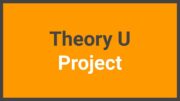
Introduction
Benefits
5 Steps
Introduction
Theory U is a framework and a change management method. The principles of Theory U help you break through past unproductive patterns of behaviour that prevent you from empathizing with other people. This often leads to ineffective patterns of decision making. The theory points out that collectively we perpetuate undesired habits. These habits become visible mainly in three divides: the ecological, the social, and the spiritual-cultural. We are exhausting the earth’s resources. Nearly half of the world population lives in poverty. Many people are detached from their inner self.
Benefits
The Theory U principles can help you create something authentically new. According to the principles, inner awareness, the ability to observe your own thoughts, feelings and reactions is essential to get there. In Theory U the relationship with a deeper source of learning and knowing that is connected with the potential of an emerging future is called presencing. It refers both to the state of being present and the attitude of sensing. Presencing helps you connect with your authentic self, which is the deepest source of inspiration and knowing. When you start creating and leading from there, new approaches and solutions become possible. In Theory U terms you shift from ego-awareness to eco-awareness and start leading from an open mind, open heart and open will.
5 Steps
The application of Theory U in a group setting consists of five steps. A concrete example is given to give you a better understanding of what it actually means to go through the U-process.
1. Intention Uncovering a shared intention (co-initiating)
For instance, teachers might feel more and more critical about their way of educating. They might long for a system in which there is the possibility to teach by using different methods.
2. Perspective Doing exercises that help see the situation from a new perspective (co-sensing)
The teachers might become students for one day.
3. Future Connecting with the highest future potential for the issue at stake (presencing)
The future potential could be the vision of the students of feeling truly supported and ready for the job market thanks to the teacher’s guidance.
4. Prototype Crystallising a new approach and developing a prototype (co-creating)
On a small scale, a new approach will be tested. Maybe the students can be taught online more often or the teacher’s role turns more into a coaching role.
5. Eco-system Developing and scaling an innovative eco-system (co-evolving)
Not every student might be interested in a new approach. There might be a need for a variety of options.

